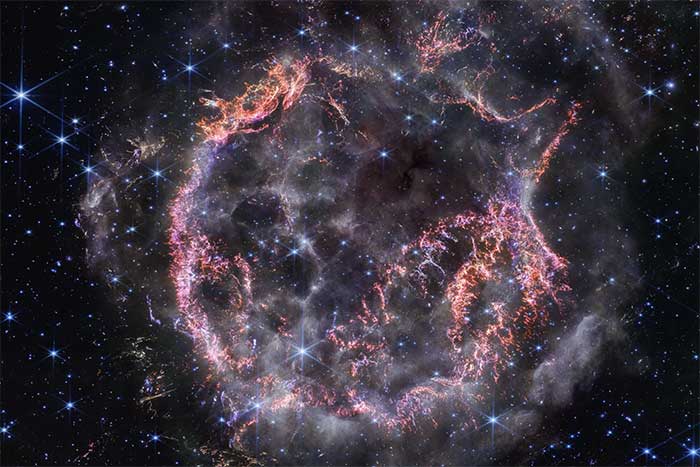NASA’s James Webb Space Telescope Captures New Images of Cassiopeia A Supernova Remnant.
On December 13, CNN reported that NASA’s James Webb Space Telescope has recently captured new images of the Cassiopeia A supernova remnant located in the Cassiopeia constellation.

Cassiopeia A supernova is 11,000 light-years from Earth. (Image: NASA)
The Cassiopeia A supernova is located 11,000 light-years away from Earth and is estimated to have exploded approximately 340 years ago from Earth’s perspective.
According to NASA, this new discovery was made possible thanks to NIRCam, an infrared camera on the James Webb Space Telescope that allows for imaging of Cassiopeia A at wavelengths previously inaccessible.
High-resolution images reveal complex details of the expanding shell of material colliding with gas released by the star before it exploded, as noted by expert Danny Milisavljevic from Purdue University, who leads the research team.
“With NIRCam’s resolution, we can now see how the dying star completely disintegrates when it explodes, leaving behind strands resembling tiny shards of glass,” he described.
The color differences recorded in the new images of Cassiopeia A, where infrared light is translated into visible light wavelengths, contain new scientific information that researchers are striving to understand.
One example is the area in Cassiopeia A in the new images showing a greenish glow in the central cavity of the glowing supernova, which the research team has nicknamed the “Green Monster.”
Researchers believe this phenomenon is due to supernova debris being pushed through and forming gas left by the star before it exploded.
However, as the team solves one mystery, they uncover another. Milisavljevic stated that the faint green light appears to be scattered with “notable circular holes.” These intriguing “voids” may have formed when supernova material nodes passed through the previously expanding stellar gas cloud released by the star.
He added: “There are very few mechanisms in the universe that can create such round objects. This seems to be the best explanation.”
Future studies of the “Green Monster” and its mysterious circles will provide astronomers with insights into the nature of the ill-fated star and what it was doing before exploding into a supernova.


















































